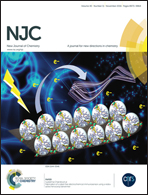Dual donor–π–acceptor type organic dyes for efficient dye-sensitized solar cells†
Abstract
A series of novel triphenylamine (TPA)-based dyes that use double linkers between the electron donor and the electron acceptor are synthesized, characterized, and applied as photosensitizers for dye-sensitized solar cells. The dyes contain N-methylpyrrole (NMP) (MTPA-2 dye) and styrene (St) (STPA-2 dye), respectively, linkers on TPA. These linkers are expected to generate effective π-conjugation forming donor–π–acceptor (D–π–A) links. The photovoltaic performance of the dyes depends on the linker type. For the dual-St-π-linked dye, the charge transfer from the excited dye molecules to the conduction band of TiO2 is improved, making the efficiency of the corresponding devices higher than those of dye-based devices with NMP linkers and no linkers. The device with the dye bearing positions of C3 and C4 on NMP linkers has the lowest conjugation effect and efficiency. In particular, the STPA-2 dye shows a broad incident-photon-to-current conversion efficiency response with a signal of up to 700 nm, covering most of the ultraviolet-visible light region. Device efficiencies of 5.43% and 7.56% for dye-sensitized devices using the STPA-2 dye and the cis-RuL2(NCS)2 (N3) dye, respectively, were fabricated using the same method and measured under AM 1.5 irradiation.


 Please wait while we load your content...
Please wait while we load your content...